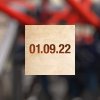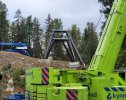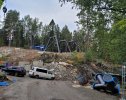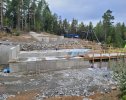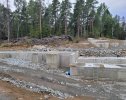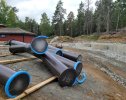FORUMS - COASTERFORCE
You are using an out of date browser. It may not display this or other websites correctly.
You should upgrade or use an alternative browser.
You should upgrade or use an alternative browser.
TusenFryd | Storm | Gerstlauer Invert | 2023
- Thread starter Pokemaniac
- Start date
davidm
Strata Poster
Storm - Dragonville - Nyheter 2023 | TusenFryd
TusenFryd bygger ny berg-og-dalbane til 100 millioner som skal stå klar til 2023.
 www.tusenfryd.no
www.tusenfryd.no
Press Release ; https://www.tusenfryd.no/en/presse/pressemelding-010922
First "suspended, triple-launch" track in Europe
The new attraction is based on a principle called "suspended, triple launch". This means that the unit the passenger sits in is suspended under the rail passage itself (suspended). Triple launch means that you accelerate three times during the trip. First from the start before the wagon set stops and then accelerates backwards. At one point it stops again before accelerating for the third time, then forward.
Installs the track from 1 September
- We started the groundwork for the new roller coaster already in March 2020. Then came the pandemic, and the process was put on hold. But last November we were able to continue the foundation work. Now the support and rail track have just arrived from the supplier, and on 1 September work will begin to erect the supporting structure before the rail track is installed. We are really looking forward to seeing it take shape, but most of all to the public getting to experience it from next season, says managing director Bjørn Håvard Solli in Tusenfryd.
cookie
Giga Poster
So they use concept art where the track is red and ride animation where the track is yellow, but in reality the track is blue.Storm - Dragonville - Nyheter 2023 | TusenFryd
TusenFryd bygger ny berg-og-dalbane til 100 millioner som skal stå klar til 2023.www.tusenfryd.no
Press Release ; https://www.tusenfryd.no/en/presse/pressemelding-010922
oriolat2
Giga Poster
exactly what I thought xDSo they use concept art where the track is red and ride animation where the track is yellow, but in reality the track is blue.
It strikes me as laziness (or frugal-ness) - I wonder if the red, yellow and blue has been options along the way and they weren't willing or able to get the renderings updated for the final blue colour scheme, so just left them in as the work in progress colours.
oriolat2
Giga Poster
As a whole, this project screams laziness. After all, it's Parques Reunidos we are talking about. They are going to do the bare minimum to keep milking the park. After a long (meaningful) coaster drought, this Gerstlauer inverted coaster looks half-assed. In fact, it looks like the inverted version of Gold Rush at Slagharen, which also happens to be a Gerstlauer and at a PR park.It strikes me as laziness (or frugal-ness) - I wonder if the red, yellow and blue has been options along the way and they weren't willing or able to get the renderings updated for the final blue colour scheme, so just left them in as the work in progress colours.
TPoseOnTantrum
Giga Poster
The difference with Slagharen however is that it was an intentionally rushed replacement. They’d spent the past few years trying to prop up a frequently-broken Thunder Loop - who’s time was quickly running out - on the basis that they couldn’t function without a headline coaster. When Slagharen finally made the call to cut their losses with the coaster, they went to Gerstlauer because they’re the rare company that can get a major custom coaster project developed, manufactured, and commissioned within 12 months.In fact, it looks like the inverted version of Gold Rush at Slagharen, which also happens to be a Gerstlauer and at a PR park.
Tusenfryd’s had a lot more time to work on this. I’m not going to call PR lazy on this front because it’s obvious that they have put and will continue to put a lot more money into the park, but the coaster could indeed have seen more development to it. I think it’s fine, personally.
I'm leaning more towards the municipality demanding a less visually striking colour scheme that blended better into the sky. The coaster is quite close to a residential area, after all. Speed Monster was also conceived as yellow at some point, but changed to blue quite late in development.It strikes me as laziness (or frugal-ness) - I wonder if the red, yellow and blue has been options along the way and they weren't willing or able to get the renderings updated for the final blue colour scheme, so just left them in as the work in progress colours.
CrashCoaster
CF Legend
I wonder if this coaster will feel rougher than a typical Gerst or whether it'll feel about the same. Either way, the lapbar-only trains should help a lot.
One thing we can tell for certain: the capacity of this is going to be awful.
It has one train with 16 seats. The POV ride time, from the train starts until it stops, is 47 seconds. With all the faff of loading and unloading, we'd be lucky to see a three-minute ride cycle. That means 20 cycles per hour, a capacity of 320 pph. If the ride cycle is increased to four minutes on average (this is Tusenfryd after all), we're down to 240 pph. Let's assume it's 250, for easy calculations.
The park is open from 10 to 19 in high season, but it's unlikely the coaster will open before 11. Maybe close at 18 too. Let's assume the coaster will be open for eight hours a day. At 250 pph, it means it will serve 2000 guests per day. At 320 pph, 2560 guests. Or perhaps more accurately, 2560 rides. Some might want to ride the coaster several times.
Problem is, on an average day during high season, the park is visited by 4000 guests. Granted, this includes a lot of children who'd be too small to ride, and adults who'd skip it for other reasons, but it still means the coaster can only accommodate half the daily visitors to the park on an average day. On a busy day, attendance can exceed 8000, or 11000 on a really busy day. On such days, they better hope less than a quarter of the guests will want to ride Storm (once), because it simply cannot serve any more than that.
For comparison, Thundercoaster features two trains with 24 seats each, while Speed Monster has two trains of 12 seats (but a much shorter ride cycle). Loopen has one train of 28 seats. One train of 16 riders will be rough, even with a very short ride time. That's too little for what is essentially the park's new headliner attraction.
It has one train with 16 seats. The POV ride time, from the train starts until it stops, is 47 seconds. With all the faff of loading and unloading, we'd be lucky to see a three-minute ride cycle. That means 20 cycles per hour, a capacity of 320 pph. If the ride cycle is increased to four minutes on average (this is Tusenfryd after all), we're down to 240 pph. Let's assume it's 250, for easy calculations.
The park is open from 10 to 19 in high season, but it's unlikely the coaster will open before 11. Maybe close at 18 too. Let's assume the coaster will be open for eight hours a day. At 250 pph, it means it will serve 2000 guests per day. At 320 pph, 2560 guests. Or perhaps more accurately, 2560 rides. Some might want to ride the coaster several times.
Problem is, on an average day during high season, the park is visited by 4000 guests. Granted, this includes a lot of children who'd be too small to ride, and adults who'd skip it for other reasons, but it still means the coaster can only accommodate half the daily visitors to the park on an average day. On a busy day, attendance can exceed 8000, or 11000 on a really busy day. On such days, they better hope less than a quarter of the guests will want to ride Storm (once), because it simply cannot serve any more than that.
For comparison, Thundercoaster features two trains with 24 seats each, while Speed Monster has two trains of 12 seats (but a much shorter ride cycle). Loopen has one train of 28 seats. One train of 16 riders will be rough, even with a very short ride time. That's too little for what is essentially the park's new headliner attraction.
CrashCoaster
CF Legend
Progress is coming on nicely:-


 www.instagram.com
www.instagram.com


coasterblog.se on Instagram: "Storm - The Dragon Legend 🐉 Work in progress on Gerstlauer's suspended triple launch coaster at Tusenfryd. #gerstlauer #gerstlaueramusementrides #tusenfryd #suspendedcoaster #inverted #rollercoasters #coasteroftheday #
1,206 likes, 7 comments - coasterblog.se on September 14, 2022: "Storm - The Dragon Legend 🐉 Work in progress on Gerstlauer's suspended triple launch coaster at Tusenfryd. #gerstlauer #gerstlaueramusementrides #tusenfryd #suspendedcoaster #inverted #rollercoasters #coasteroftheday...
 www.instagram.com
www.instagram.com
Last edited:
HandsUpPantsDown
Roller Poster
Progress is coming on nicely:-


coasterblog.se on Instagram: "Storm - The Dragon Legend 🐉 Work in progress on Gerstlauer's suspended triple launch coaster at Tusenfryd. #gerstlauer #gerstlaueramusementrides #tusenfryd #suspendedcoaster #inverted #rollercoasters #coasteroftheday #
1,206 likes, 7 comments - coasterblog.se on September 14, 2022: "Storm - The Dragon Legend 🐉 Work in progress on Gerstlauer's suspended triple launch coaster at Tusenfryd. #gerstlauer #gerstlaueramusementrides #tusenfryd #suspendedcoaster #inverted #rollercoasters #coasteroftheday...www.instagram.com
I am interested in this construction technique of temporarily anchoring the supports with those lines. Does anyone know the reason for this? I would assume the supports should be able to stand up themselves without the tethers, purely from through anchor bolts,
Regardless, that element looks nice!
It could be that the supports are dependent on the track for the lateral stability - notice how the straps are all at angles to the support. Could it be that they need tethering in the left/right direction? When the track is installed it would provide that direction of stability. They're tied back that far to keep out of the way of the access below the track where the cranes are more likely to move. My best guess, anyway.I am interested in this construction technique of temporarily anchoring the supports with those lines. Does anyone know the reason for this? I would assume the supports should be able to stand up themselves without the tethers, purely from through anchor bolts,
The meeting of the support with the footer is strange - does someone have a closeup? Does the support actually fasten into the footer below the top level of the footer, or is it a camera/perspective trick?
Indy
Hyper Poster
I believe they are necessary until the concrete has been poured. I've always found Gerstlauer's anchor style to be strange, but it's proving to be even more strange than I ever realized...I am interested in this construction technique of temporarily anchoring the supports with those lines. Does anyone know the reason for this? I would assume the supports should be able to stand up themselves without the tethers, purely from through anchor bolts,
Gerstlauer never leaves their base plates exposed. Instead, they set them in concrete so it's as if a support has just sprouted out of a footer. They aren't the only company to take this approach, but it's not common. In theory, you set the support, tighten the nuts on the anchor rods, and then cover it in concrete. Then, you never have to periodically torque the bolts to make sure they are still tight because it is accepted that the concrete will ensure they never loosen. At least that's the case if you have anchor bolts...
I'm now almost positive they don't. Here is a photo from earlier in the thread...Does the support actually fasten into the footer below the top level of the footer, or is it a camera/perspective trick?
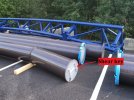
That little "H" is a shear key, which is a common feature on the underside of the base plates on almost all larger coasters that use large tubular supports. It helps to pass any sort of lateral or torsional load into the foundation. Typically, the base plate that the shear key is welded to would also have large bolt holes. Anchor rods are usually set in a concrete footer and you thread the anchor rods through the bolt holes when lowering the support into place. Then, you take large washers and nuts and tighten the support to the anchor rods. Once construction of the entire ride is complete, you fill in the pocket where the shear key rests with cementitious grout and then torque the nuts. Done.
As you can clearly see in this photo, there are no bolt holes which is pretty wild. It seems that they literally pour a giant pocketed footer and set the support down into it with no anchor rods whatsoever. They rely completely on the concrete to hold the support in place. So, they probably have all of those supports strapped to some sort of anchor to provide stability until the concrete has been poured and cured. It is a pretty strange approach.

